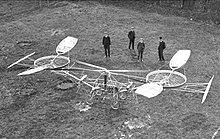Paul Cornu


Paul Cornu (French pronunciation: [pɔl kɔʁny]; 15 June 1881 – 6 June 1944) was a French engineer.
Life
[edit]Paul Cornu, of Romanian origins,[1] was born in Glos la Ferrière, France and was one of thirteen children. At a young age, he helped his father in his transports company.[2] He made history by designing the world's first successful manned rotary wing aircraft.
Cornu first built an unmanned experimental design powered by a 2 hp Buchet engine.[3]
His manned helicopter was powered by a 24 horsepower (18 kW) Antoinette engine.[4] He piloted this construction himself at Normandy, France on 13 November 1907.[5] Previously, a French helicopter, the Breguet-Richet Gyroplane I, had managed to lift off under its own power, but it had been held in position by men standing on the ground. Cornu's performance was a considerable progress because his aircraft flew without additional support and lifted Cornu about 30 cm (1 ft) for 20 seconds. Unfortunately this early helicopter was scarcely maneuverable and had only a few additional flights. The construction was not much further developed by this technical pioneer, who had to keep on making a living by manufacturing bicycles.
Death
[edit]Paul Cornu died aged 62 in 1944 in Lisieux, France, when his home was destroyed during the bombardment by the Allies that accompanied the Normandy landings of World War II.[citation needed]
References
[edit]- ^ Petrescu, Florian Ion; Petrescu, Relly Victoria (2012). The Aviation History. ISBN 9783848230778.
- ^ Pike, John. "Cornu Helicoplane". www.globalsecurity.org. Retrieved 2018-08-09.
- ^ "Hélicoptère Cornu et fils à Propulseur Spécial". L'Aérophile (in French): 146. June 1906.
- ^ eurocopter.com Archived 2007-05-04 at the Wayback Machine
- ^ Gibbs-Smith, Charles H. (3 Apr 1959). "Hops and Flights: A roll call of early powered take-offs". Flight. 75 (2619): 470. Retrieved 24 Aug 2013.
